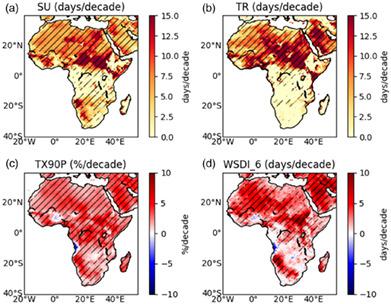当前位置:
X-MOL 学术
›
Int. J. Climatol.
›
论文详情
Our official English website, www.x-mol.net, welcomes your
feedback! (Note: you will need to create a separate account there.)
Changes in temperature and heat waves over Africa using observational and reanalysis data sets
International Journal of Climatology ( IF 3.5 ) Pub Date : 2021-07-11 , DOI: 10.1002/joc.7295 Mastawesha Misganaw Engdaw 1, 2 , Andrew P. Ballinger 3 , Gabriele C. Hegerl 3 , Andrea K. Steiner 1, 4
International Journal of Climatology ( IF 3.5 ) Pub Date : 2021-07-11 , DOI: 10.1002/joc.7295 Mastawesha Misganaw Engdaw 1, 2 , Andrew P. Ballinger 3 , Gabriele C. Hegerl 3 , Andrea K. Steiner 1, 4
Affiliation

|
Providing comprehensive regional- and local-scale information on changes observed in the climate system plays a vital role in planning effective and efficient climate change adaptation options, specifically over resource-limited regions. Here, we assess changes in temperature and heat waves over different regions of the African continent, with a focus on spatiotemporal trends and the time of emergence of change in hot extremes from natural variability. We analyse absolute and relative threshold indices. Data sets include temperatures from observations (CRUTS4.03 and BEST) and from three representative state-of-the-art reanalyses (ERA5, MERRA2 and JRA-55) for the common period 1980–2018. Statistically significant warming is observed over all regions of Africa in temperature time series from CRU observations and reanalysis data, although the trend strength varies between data sets. Also, extreme temperatures and heat wave indices from BEST observations and all reanalysis data sets reveal increasing trends over all regions of the African continent. However, there are differences in both trend strength and time evolution of heat wave indices between different reanalysis data sets. Most data sets agree in identifying 2010 as a peak heat year over Northern and Western Africa while Eastern and Southern Africa experienced the highest heat wave occurrence in 2016. Our results clearly reveal that heat wave occurrences have emerged from natural climate variability in Africa. The earliest time of emergence takes place in the Northern Africa region in the early 2000s while in the other African regions emergence over natural variability is found mainly after 2010. This also depends on the respective index metrics, where indices based on more consecutive days show later emergence of heat wave trends. Overall, significant warming and an increase in heat wave occurrence is found in all regions of Africa and has emerged from natural variability in the past one or two decades.
中文翻译:

使用观测和再分析数据集的非洲温度和热浪变化
提供有关在气候系统中观察到的变化的综合区域和地方尺度信息在规划有效和高效的气候变化适应方案方面发挥着至关重要的作用,特别是在资源有限的地区。在这里,我们评估了非洲大陆不同地区的温度和热浪变化,重点关注时空趋势和自然变率导致极端高温变化的出现时间。我们分析绝对和相对阈值指数。数据集包括 1980-2018 年共同时期的观测温度(CRUTS4.03 和 BEST)和三个具有代表性的最先进的再分析(ERA5、MERRA2 和 JRA-55)。根据 CRU 观测和再分析数据,在非洲所有地区的温度时间序列中观察到统计上显着的变暖,尽管趋势强度因数据集而异。此外,来自 BEST 观测和所有再分析数据集的极端温度和热浪指数揭示了非洲大陆所有地区的增长趋势。然而,不同再分析数据集之间的热浪指数趋势强度和时间演化存在差异。大多数数据集都同意将 2010 年确定为北部和西部非洲的热浪高峰年,而东部和南部非洲在 2016 年经历了最高的热浪发生。我们的结果清楚地表明,热浪的发生源于非洲的自然气候变化。最早出现在 2000 年代初期的北非地区,而在其他非洲地区,出现超过自然变异的出现主要是在 2010 年之后。这也取决于各自的指数指标,其中基于更多连续天数的指数显示后来出现的热浪趋势。总体而言,在非洲所有地区都发现了显着变暖和热浪发生的增加,并且在过去一二十年中出现了自然变化。
更新日期:2021-07-11
中文翻译:

使用观测和再分析数据集的非洲温度和热浪变化
提供有关在气候系统中观察到的变化的综合区域和地方尺度信息在规划有效和高效的气候变化适应方案方面发挥着至关重要的作用,特别是在资源有限的地区。在这里,我们评估了非洲大陆不同地区的温度和热浪变化,重点关注时空趋势和自然变率导致极端高温变化的出现时间。我们分析绝对和相对阈值指数。数据集包括 1980-2018 年共同时期的观测温度(CRUTS4.03 和 BEST)和三个具有代表性的最先进的再分析(ERA5、MERRA2 和 JRA-55)。根据 CRU 观测和再分析数据,在非洲所有地区的温度时间序列中观察到统计上显着的变暖,尽管趋势强度因数据集而异。此外,来自 BEST 观测和所有再分析数据集的极端温度和热浪指数揭示了非洲大陆所有地区的增长趋势。然而,不同再分析数据集之间的热浪指数趋势强度和时间演化存在差异。大多数数据集都同意将 2010 年确定为北部和西部非洲的热浪高峰年,而东部和南部非洲在 2016 年经历了最高的热浪发生。我们的结果清楚地表明,热浪的发生源于非洲的自然气候变化。最早出现在 2000 年代初期的北非地区,而在其他非洲地区,出现超过自然变异的出现主要是在 2010 年之后。这也取决于各自的指数指标,其中基于更多连续天数的指数显示后来出现的热浪趋势。总体而言,在非洲所有地区都发现了显着变暖和热浪发生的增加,并且在过去一二十年中出现了自然变化。











































 京公网安备 11010802027423号
京公网安备 11010802027423号